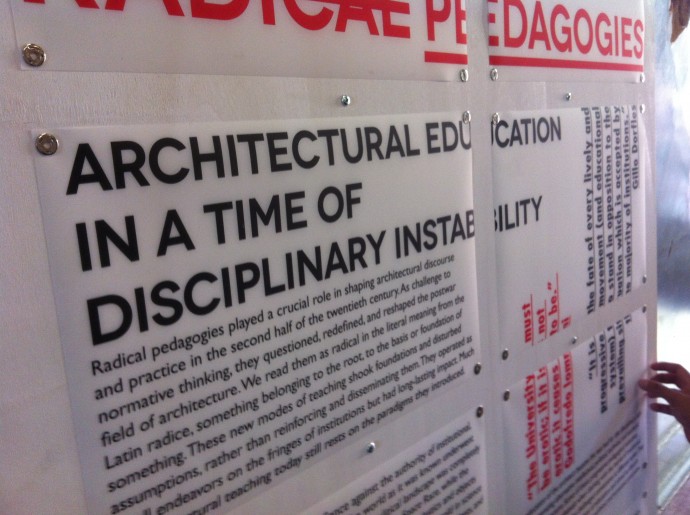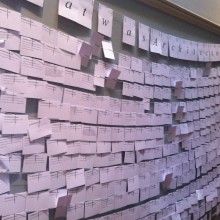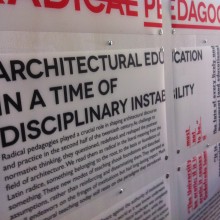Close Closer, the Perec-esque Triennale

“What we need to question is bricks, concrete, glass, our table manners, our utensils, our tools, the way we spend our time, our rhythms. To question that which seems to have ceased forever to astonish us. We live, true, we breathe, true; we walk, we go downstairs, we sit at a table in order to eat, we lie down on a bed on order to sleep. How? Where? When? Why?
Describe your street. Describe another. Compare.”
― Georges Perec, L’infra Ordinaire
When you face the blank page to write about an architectural event that has been [and it’s been] widely discussed, the first thing to write is “what for?” Following Brendan Cormier’s question “What’s the use of an architecture triennal review?” maybe there’s no other motivation than to share the way you perceive an event which is wide enough that no one’s can give a complete vision of it, thus we can be one more piece of the puzzle that complete the whole program.
We’re not going to describe here the Lisbon Architecture Triennale program, which is easy to find on their web-site [Close, Closer]. Beyond that, maybe we can share our feelings and thoughts apropos the Triennale, after spending a few days at the opening… And the best way to describe them is as Perec-esque feelings. George Perec on his book L’infra Ordinaire poses a call for action to rethink the way we relate with our immediate surroundings, how we behave, walk, and live our cities and also how we share, communicate and relate with others. On that sense, one of the most positive approaches that can be found at the Triennale is the dispersion of venues and events: they force you to walk in the city, to perceive what is happening in the architectural context in Lisbon, and after that, to question what can we do from our practice.
Discurso Visível: Pelin Tan from Francisca Benitez on Vimeo.
Jose Esparza’s New Publics can be understood as a catalyst for action and thought. Located in a central square of the city, Praça da Figueira and using as platform the Civic Stage designed by Frida Escobedo [which fortunately is static and doesn’t move as planned], it was maybe the most active space we saw at the opening week, and by active I don’t mean only physical activity; I’m referring also about transdisciplinarity and ideas exchange. At this stage it was possible to see a sociologist such as Pelin Tan interacting with local skaters accompanied by Francisca Benítez, providing Portuguese Sign Language (LGP) interpretation for the act; a round table from Princeton University leaving their academic podiums in search for the shadow of a horse to have an interesting conversation about Radical Pedagogies or one of the participants, Daniel Fernández Pascual, talking about the failures to develop his proposed project, The Housing Act.
At this point one is reminded about Manfredo Tafuri’s statement “there is no such thing as criticism, only history.” An event that is held every three years can’t be criticized or judged only in three days. Until now, it hasn’t been possible to evaluate if The Institute Effect will succeed in showing other institutional ways to face the needs of architecture and education nowadays or if the associated research project Radical Pedagogies will have any future influence to change how education and accreditations are managed at the moment and try to engage the participation of students once again, as it happened in the past.
Young curators, architects and practitioners are trying to explore the limits of architecture and with failures of course [Who can name here the perfect architecture event? Or the perfect curator?], one of the most valuable things of the Triennale is that it’s giving a place to ask questions. The Crisis Buster grant gave the opportunity to ten young practices to develop their projects in different locations, such as A Cozinha da Casa do Vapor in the South of Lisbon or the project Geniuos Loci, which has invited local restaurants to participate on the program with the aim to improve local business and citizen’s participation. The Associated Projects are also a proper tool not only for young people to participate, but most important, to have a mental map of the concerns in architecture students and practitioners nowadays.
More than sixty years ago, Hans Hollein stated that Alles ist Architektur [everything is architecture] and possibly one of the main problems to understand the Triennale’s approach can be find on this statement. Is science fiction architecture? Is trendy organic food architecture? Is occupying the public space architecture? Is a performance architecture? In the current, convulse, and ever changing times for the architectural practice, it’s understandable that our main concerns are all about the possible responses to what architecture is and what architecture can be. After long conversations and thinking about this issue, maybe our bigger misunderstanding is try to evaluate the results of an event as Close Closer, which is not only about a curatorial statement and it’s not only about the work of a group of young curators that are trying to give to the public a platform to discuss this questions. Maybe the misunderstanding is based on the visitors’ expectations when thinking that one single architecture event can give the answers to this complex set of questions.
So, let’s follow Perec and keep on wondering How? Where? When? Why?
—Ethel Baraona Pohl, editorial team Quaderns.





